Processes
Plasma Processes offers a wide range of manufacturing and coating processes, each with unique characteristics that make it attractive for specific applications. Our core competencies include a complete family of thermal spray processes, and EL-Form® electrodeposition for coatings and net-shape manufacturing; Powder Alloying and Spheroidization for the production and toll processing of spherical and alloyed powders; and a complete metallurgical laboratory for material analysis and characterization. Additionally, we offer consulting and contract research and development.
Vacuum Plasma/Low-Pressure Plasma Spray
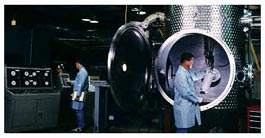
Vacuum Plasma Spray (also referred to as Low-Pressure Plasma Spray) combines all the advantages of plasma spray within an inert environment to produce very dense coatings with the lowest oxide content. Vacuum Plasma Spray is cost effective for the spray forming of specialized materials, refractory metals and reactive materials (e.g. titanium). Vacuum Plasma Spray offers the following advantages over conventional atmospheric plasma process:
- Broader and longer spray jets
- Cleaner interfaces through reverse transfer arc sputter cleaning
- Oxide-free coatings
- High coating densities (close to theoretical)
- Low residual stresses
- Increased deposition thickness capability (>25mm or 1 inch)
- High substrate/deposit preheating capability
Applications:
- Planar and cylindrical sputter targets
- Thermal Barrier Coatings
- Medical Device and Implant Coatings
- Refractory Metals
- Dense Ceramics
- Superalloys
- Rocket Nozzles
Shrouded Plasma Spray
Shrouded Plasma Spray offers the versatility of atmospheric plasma spray within an inert atmosphere. A shroud of protective gas surrounds the plasma jet and reduces the amount of oxygen available to oxidize the material being deposited. Shrouded Plasma Spray is used for oxygen-sensitive applications where functionality, size and budget do not require vacuum plasma spray deposition.
Applications:
Oxidation-resistant coatings
Thermal barrier coatings (TBC’s)
Corrosion-resistance
Neutron absorbing materials
Medical device and implant coatings
Atmospheric Plasma Spray
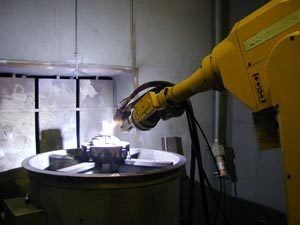
Atmospheric Plasma SprayThe most flexible of thermal spray processes with ability to coat virtually any material while achieving excellent control of coating thickness and surface characteristics.
A strong electric arc is generated between a positively charged pole (anode) and a negatively charged pole (cathode). This ionizes the flowing process gases into the plasma state. Powdered feedstock material is injected into the plasma jet, melting the powder particles and propelling them to the surface of the workpiece.
Applications:
Oxidation-resistant coatings
Thermal barrier coatings
Corrosion-resistance
Neutron absorbing materials
Medical device and implant coatings
Wear resistant
Electircal contacts
Cold Spray | 3D Painting
Cold Spray is a material-deposition process whereby particles between 1 and 40 microns are impacted at high velocity onto a substrate. The particles are placed in a gas stream of nitrogen, helium or air, then heated and accelerated through a de Laval supersonic nozzle at speeds ranging from 1000 to 2500 meters per second. The particle stream is directed towards a substrate, where the particles are consolidated in the solid state.
A distinguishing feature of the cold spray process compared to conventional thermal spray processes is its ability to produce coatings in a range generally lower than the melting temperature of the coating. Consequently, deleterious effects of high-temperature oxidation, evaporation, melting, recrystallization, residual stresses, debonding, and other concerns associated with thermal spray methods with a liquification step are minimized or eliminated. Cold Spray coatings are typically limited to ductile materials like aluminum, stainless steel, copper, titanium and alloys. Hard and brittle materials like ceramics cannot be sprayed in the pure form but may be applied as composites with a ductile matrix phase. Substrate materials are also limited to those that can withstand the aggressive action of the spray particles. Soft or friable substrates will erode rather than be coated.
Applications:
Additive/3D Printing
Aerospace (MCrAlY)
Automotive; corrosion protection for automotive body and chassis structures (Al and Zn)
Chemical (Ti)
Rapid Protyotyping
Rapid Tooling Repair
Dimensional Restoration (Al, Mg, Cu, Steel)
Wire Arc Spray
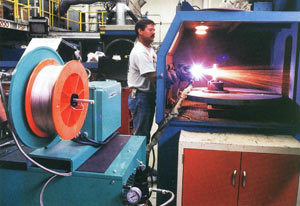
Wire Arc SprayWire Arc Spray (also referred to as Electric Arc Spray) is a simple, fast and economical thermal spray process for in-shop or on-site work. Wire arc spray works by placing an electric arc between two consumable electrodes of a coating material, then using compressed gas to atomize and propel the material to the substrate. Wire Arc Spray occupies an important niche in thermal spray technology and is particularly suited to high-rate deposition.
Applications:
Corrosion Protection
Non-skid surfaces
Low-temperature-capability for coatings onto substrates such as polymers and paper
Erosion- and wear-resistant coatings
Dimensional restoration
Metalizing
Electromagnetic shielding
EL-Form® Electrodeposition
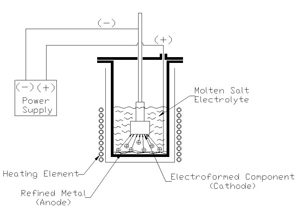
EL-Form® electrodeposition is a versatile process producing extremely pure, dense and ductile refractory and platinum group metal structures, coatings and foam. Deposited from a non-toxic, molten salt electrolyte, EL-Form® products are virtually non-porous with typical densities greater than 99% and exhibit high ductility due to controlled grain growth and purity. EL-Form® is also versatile, producing micron to millimeter thick coatings and net-shape components; and is well suited to metals including iridium, niobium, rhenium, ruthenium, tungsten, molybdenum, hafnium and boron.
Applications:
- Crucibles
- High-performance combustion chambers
- High-performance nozzles, nozzle inserts and pintles
- Electrodes
- Sputter Targets
- Medical Devices
- Tubing, Sheet, Foil and Foam
- Metal Refining and Reclamation
- Catalyst
High-Velocity OxyFuel
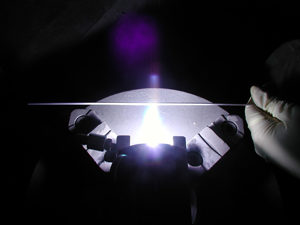
High Velocity Oxy FuelHigh-Velocity OxyFuel (also referred to as HVOF) is a type of thermal spray process used to apply very dense coatings in a wide variety of materials. Coatings applied by HVOF usually have better mechanical properties than those applied by air plasma spray. The HVOF process is now widely used to apply tungsten carbide coatings as an environmentally friendly alternative to chromium plating on high strength steel aircraft structural components.
Applications:
Application of wear-resistant coatings such as tungsten carbide and nickel chromium carbide
Corrosion-resistant coatings such as titanium, Hastelloy® and Inconel®
Dimensional restoration (journal and shaft repair)
Non-carcinogenic, hard chrome replacement
Powder Processing
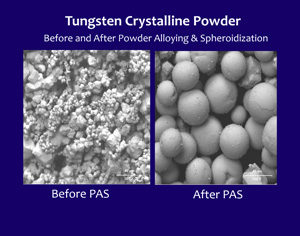
Powder Alloying & Spheroidization (PAS) transforms flaky and angular powder particles into spheres, resulting in free-flowing powder feedstock with enhanced physical characteristics such as:
Spherical Particle Shapes
High Density
Improved Flow
Low Oxygen Content
Controlled Particle Size Distribution
Alloying
Custom powder formulation
Virtually any powder or powder alloy, including crystalline, spray-dried, blended, agglomerated and composite powders, can be processed. Alloys can also be created by combining powder particles in the molten state. Processed powders typically feature spherical morphology, improved flow characteristics, greater packaging densities and a reduction in trace elements as compared to feedstock. Powders can be processed in the following enviroments: inert, ari or reactive.
Applications:
Rapid Prototyping
Thermal Spraying
Laser Cladding
Metal Injection Molding
Packing Density
Hardfacing
Piezoelectric Devices
Medical Applications
Contract Research and Development
Plasma Processes offers confidential Contract Research & Development with focus on your finished product. Our experienced team of professionals provides services ranging from materials selection to prototype development.
Services include:
Material recommendations
Testing and characterization
Proof-of-concept validation
Initial prototype development
Low rate production
High rate production
Metallurgical Analysis
Plasma Processes has a fully equipped metallurgical laboratory with capabilities for testing and evaluating materials. Our in-depth technical understanding of materials and their applications is one of our key strengths.
Our in-house metallurgical lab is capable of performing the following tests:
Metallography and Microstructural Analysis
Hardness Testing
Surface Roughness
Bend Test
Bond Strength
Image Analysis
Scanning Electron Microscope with Energy Dispersive Spectrometer
Microhardness testing
Density testing
Emissivity testing